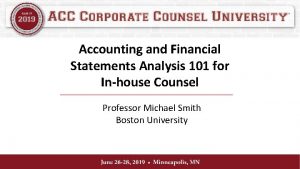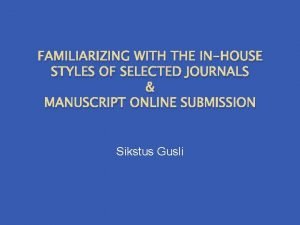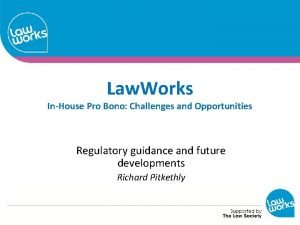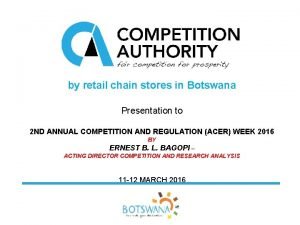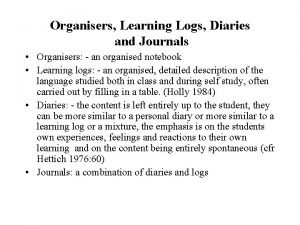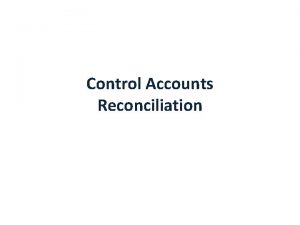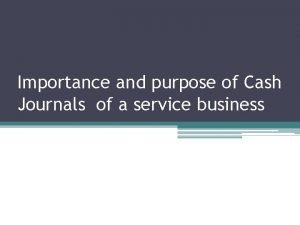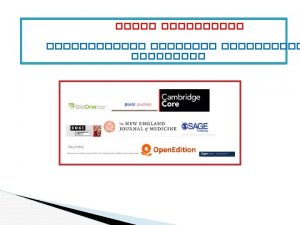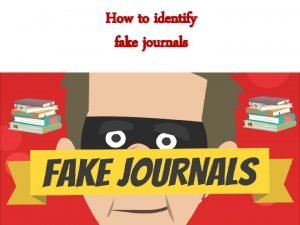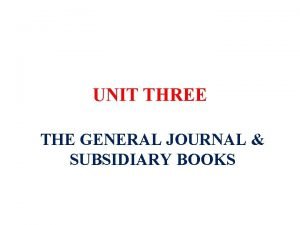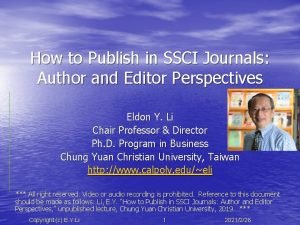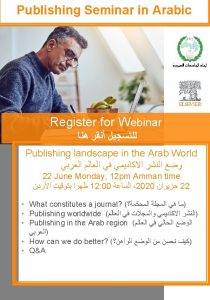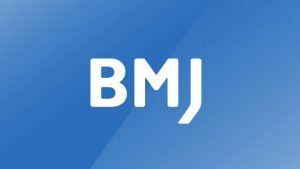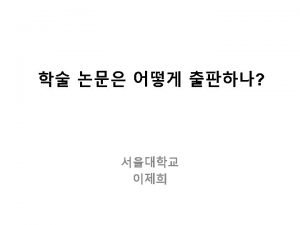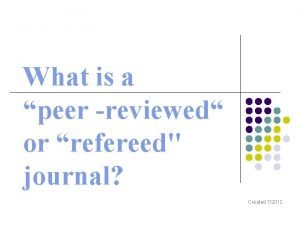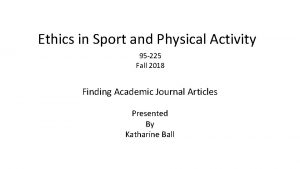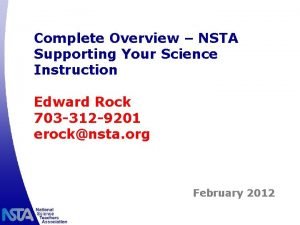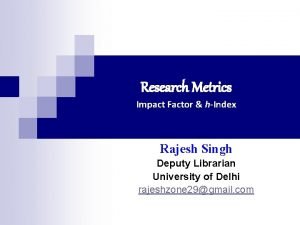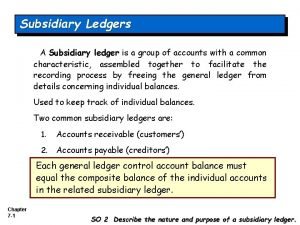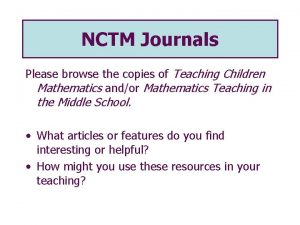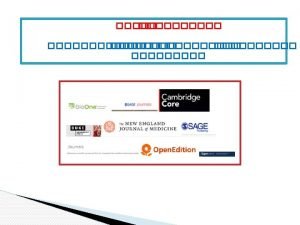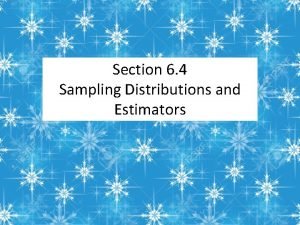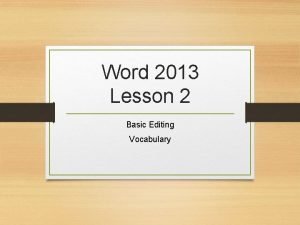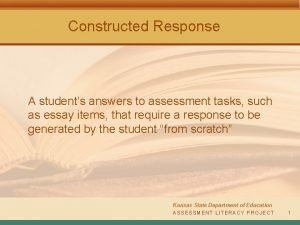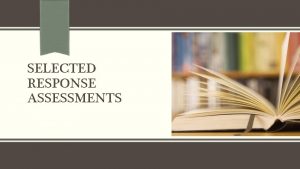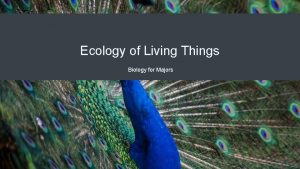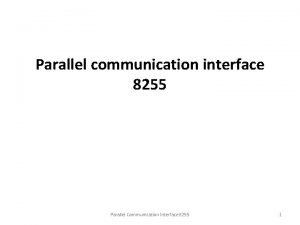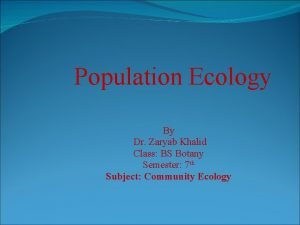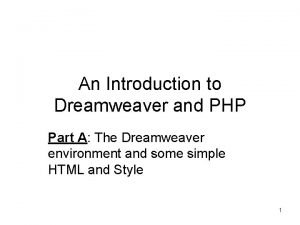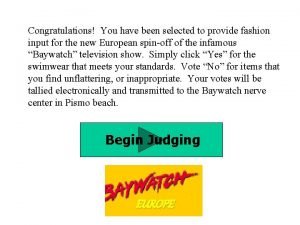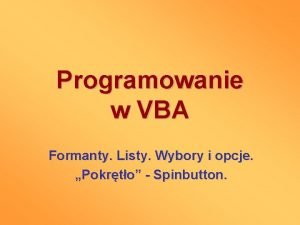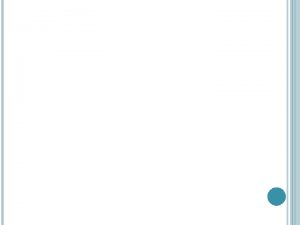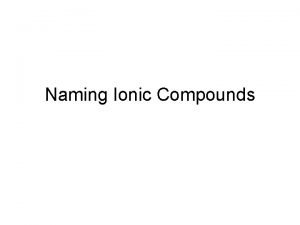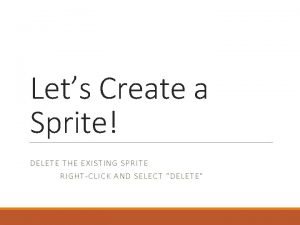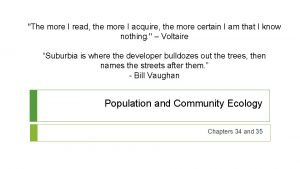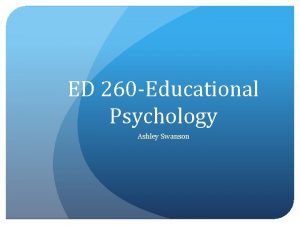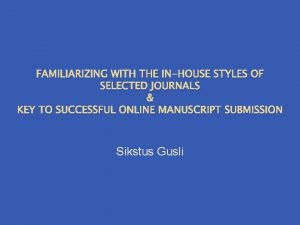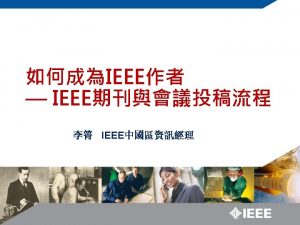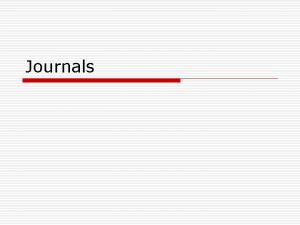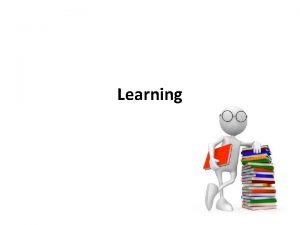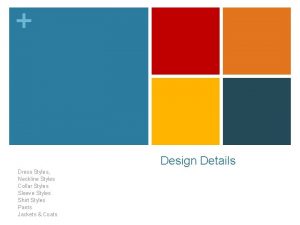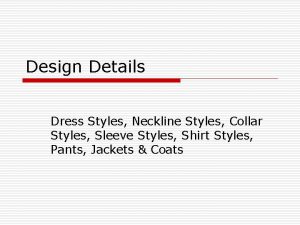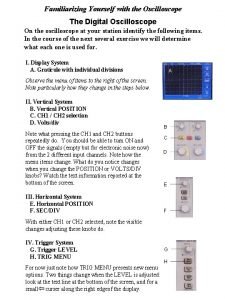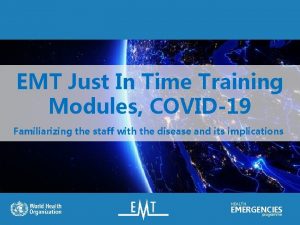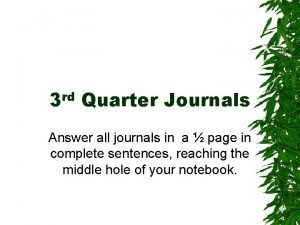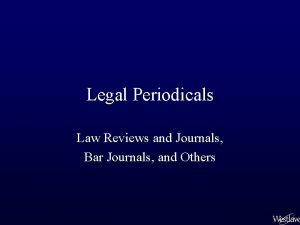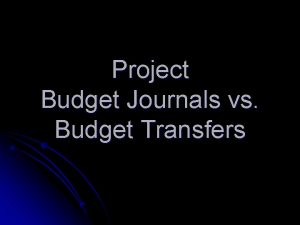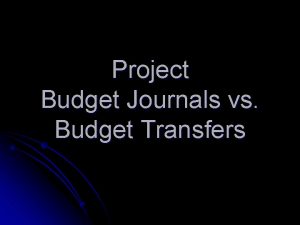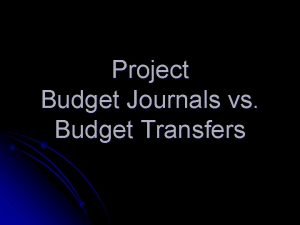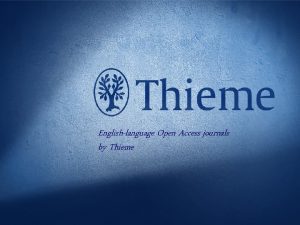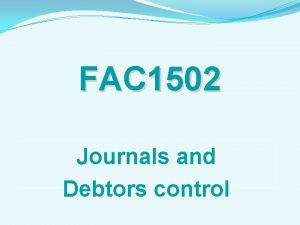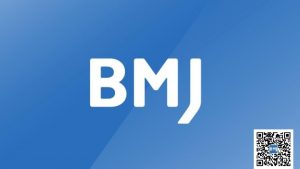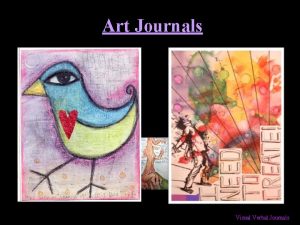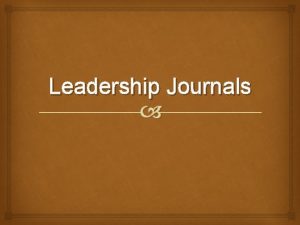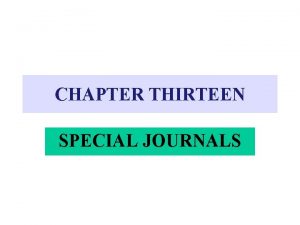FAMILIARIZING WITH THE INHOUSE STYLES OF SELECTED JOURNALS
























































































- Slides: 88

FAMILIARIZING WITH THE IN-HOUSE STYLES OF SELECTED JOURNALS & MANUSCRIPT ONLINE SUBMISSION Sikstus Gusli

Content 1. GFA in detail � Introduction to GFA: Why GFA is important? � GFA of Soil & Tillage Res journal (Elsevier), as an example Before you begin: Things you need to know Preparation After acceptance 2. Online submission

What do you think? � Suppose, you were travelling to a place for a recreation, the place you have never been before, and you are unfamiliar with. Would you: just go without information? It is simple! 2. find some information from any source available? 3. prefer to have a complete and trusted information about the place, the journey, etc. ? 1. � If your answer is 3, then for your journey to make your article published, you need to read the journal GFA!

Potential obstacles for manuscript acceptance Obstacle Where to get help? Scope appropriateness GFA Publication ethics GFA Types of publication GFA Constructing the title Discussions, examples from other articles, scientific writing books, GFA Writing the Abstract Examples from other articles, scientific writing books, GFA Authorships matters GFA IMRa. D Scientific writing books, GFA Illustrations (figures & tables) Scientific writing books, examples from other articles, & styles GFA Publication fee GFA Authors’ rights GFA Submission GFA Language GFA All helps needed GFA

So, � GFA is a complete help for you. It is absolutely necessary to read before preparing the manuscript � Read the GFA of the target journal before you begin to write � Read the newest GFA version � Read the last 2 -year articles published in the journal

Borja, 2014 (Elsevier. com): Six things to do before writing your manuscript 1. 2. 3. 4. 5. 6. Is your work it publishable? What type of manuscript to write? Choose the target journal Understand the journal requirements (GFA) Pay attention on the article structure Understand publication ethics GFA can help on this six things

Thrower, 2012 (Elsevier com): “Eight reasons I rejected you articles” 1. 2. 3. 4. 5. 6. 7. 8. It fails in the journal technical screening It does not fall within the Aims and Scope of the journal It is incomplete The procedures and/or analysis of the data is defective The conclusions cannot be justified on the basis of the rest of the paper It is simply a small extension of a different paper, often from the same authors It is incomprehensible It is boring

Common thinking mistakes � No need to worry about GFA, it is not a priority. � That is easy, I know it already. � Nothing new. GFA of all journals are the same; so, no need to read GFA may change from year to year. � Editor(s) will help me for minor writing style problems.

No Standard GFA � � Every journal has its own GFA. Don’t use GFA of a journal for other journals. GFA may be changed when needed, so read the most recently updated one

GUIDE FOR AUTHORS FOR “SOIL &TILLAGE RESEARCH” Copyright © 22 July 2017

Outline of Soil & Tillage Res. GFA, July 2016 Publisher Elsevier

General information about STR Is this the journal I am looking for? INTRODUCTION An international journal on research and development in soil tillage and field traffic, and their relationship with land use, crop production and the environment. Published in collaboration with the International Soil Tillage Research Organization (ISTRO). This ISTRO-affiliated journal examines the physical, chemical and biological changes in the soil caused by tillage and field traffic. Manuscripts will be considered on aspects of soil science, physics, technology, mechanization and applied engineering for a sustainable balance among productivity, environmental quality and profitability. The following are examples of suitable topics within the scope of the journal of Soil and Tillage Research: The agricultural and biosystems engineering associated with tillage (including no-tillage, reduced-tillage and direct drilling), irrigation and drainage, crops and crop rotations, fertilization, rehabilitation of mine spoils and processes used to modify soils. Soil change effects on establishment and yield of crops, growth of plants and roots, structure and erosion of soil, cycling of carbon and nutrients, greenhouse gas emissions, leaching, runoff and other processes that affect environmental quality. Characterization or modeling of tillage and field traffic responses, soil, climate, or topographic effects, soil deformation processes, tillage tools, traction devices, energy requirements, economics, surface and subsurface water quality effects, tillage effects on weed, pest and disease control, and their interactions. Types of paper 1. Original research papers (Regular Papers) 2. Review articles 3. Short Communications 4. Book reviews Which one?

Description of types of paper Original research papers should report the results of original research. The material should not have been previously published elsewhere, except in a preliminary form. Review articles should cover subjects falling within the scope of the journal which are of active current interest. They may be submitted or invited. A Short Communication is a concise but complete description of a limited investigation, which will not be included in a later paper. Short Communications should be as completely documented, both by reference to the literature and description of the experimental procedures employed, as a regular paper. They should not occupy more than 6 printed pages (about 12 manuscript pages, including figures, tables and references). Book Reviews will be included in the journal on a range of relevant books which are not more than 2 years old. Book reviews are solicited by the Editors-in-Chief. Please contact one of the Editors-in-Chief. Email contact details at: http: //www. elsevier. com/wps/find/journaleditorialboard. cws_home/5 03318/editorialboard

Submission checklist You can use this list to carry out a final check of your submission before you send it to the journal for review. Please check the relevant section in this Guide for Authors for more details. Ensure that the following items are present: One author has been designated as the corresponding author with contact details: • E-mail address • Full postal address All necessary files have been uploaded: Manuscript: • Include keywords • All figures (include relevant captions) • All tables (including titles, description, footnotes) • Ensure all figure and table citations in the text match the files provided • Indicate clearly if color should be used for any figures in print Graphical Abstracts / Highlights files (where applicable) Supplemental files (where applicable) Further considerations • Manuscript has been 'spell checked' and 'grammar checked' • All references mentioned in the Reference List are cited in the text, and vice versa • Permission has been obtained for use of copyrighted material from other sources (including the Internet) • A competing interests statement is provided, even if the authors have no competing interests to declare • Journal policies detailed in this guide have been reviewed • Referee suggestions and contact details provided, based on journal requirements For further information, visit our Support Center.

BEFORE YOU BEGIN

Ethics in Publishing Please see our information pages on Ethics in publishing and Ethical guidelines for journal publication. Declaration of interest (some changes on the new GFA) All authors must disclose any financial and personal relationships with other people or organizations that could inappropriately influence (bias) their work. Examples of potential conflicts of interest include employment, consultancies, stock ownership, honoraria, paid expert testimony, patent applications/registrations, and grants or other funding. If there are no conflicts of interest then please state this: 'Conflicts of interest: none'. More information.

Submission declaration and verification Submission of an article implies that the work described has not been published previously (except in the form of an abstract or as part of a published lecture or academic thesis or as an electronic preprint, see 'Multiple, redundant or concurrent publication' section of our ethics policy for more information), that it is not under consideration for publication elsewhere, that its publication is approved by all authors and tacitly or explicitly by the responsible authorities where the work was carried out, and that, if accepted, it will not be published elsewhere in the same form, in English or in any other language, including electronically without the written consent of the copyright-holder. To verify originality, your article may be checked by the originality detection service Cross. Check.

Changes to authorship Authors are expected to consider carefully the list and order of authors before submitting their manuscript and provide the definitive list of authors at the time of the original submission. Any addition, deletion or rearrangement of author names in the authorship list should be made only before the manuscript has been accepted and only if approved by the journal Editor. To request such a change, the Editor must receive the following from the corresponding author: (a) the reason for the change in author list and (b) written confirmation (e-mail, letter) from all authors that they agree with the addition, removal or rearrangement. In the case of addition or removal of authors, this includes confirmation from the author being added or removed. Only in exceptional circumstances will the Editor consider the addition, deletion or rearrangement of authors after the manuscript has been accepted. While the Editor considers the request, publication of the manuscript will be suspended. If the manuscript has already been published in an online issue, any requests approved by the Editor will result in a corrigendum.

Article transfer service This journal is part of our Article Transfer Service. This means that if the Editor feels your article is more suitable for another journal, you may be asked to consider transferring your article to the alternative journal of your choice. If you agree, your article will be transferred automatically on your behalf with no need to reformat. More information about this can be found here: http: //www. elsevier. com/authors/article-transferservice.

Copyright Upon acceptance of an article, authors will be asked to complete a 'Journal Publishing Agreement' (see more information on this). An e-mail will be sent to the corresponding author confirming receipt of the manuscript together with a 'Journal Publishing Agreement' form or a link to the online version of this agreement. Subscribers may reproduce tables of contents or prepare lists of articles including abstracts for internal circulation within their institutions. Permission of the Publisher is required for resale or distribution outside the institution and for all other derivative works, including compilations and translations. If excerpts from other copyrighted works are included, the author(s) must obtain written permission from the copyright owners and credit the source(s) in the article. Elsevier has preprinted forms for use by authors in these cases. For open access articles: Upon acceptance of an article, authors will be asked to complete an 'Exclusive License Agreement' (more information). Permitted third party reuse of

Author rights As an author you (or your employer or institution) have certain rights to reuse your work. More information. Elsevier supports responsible sharing. Find out how you can share your research published in Elsevier journals. Role of the funding source You are requested to identify who provided financial support for the conduct of the research and/or preparation of the article and to briefly describe the role of the sponsor(s), if any, in study design; in the collection, analysis and interpretation of data; in the writing of the report; and in the decision to submit the article for publication. If the funding source(s) had no such involvement then this should be stated. Funding body agreements and policies Elsevier has established a number of agreements with funding bodies which allow authors to comply with their funder's open access policies. Some funding bodies will reimburse the author for the Open Access Publication Fee. Details of existing agreements are available online.

Open access This journal offers authors a choice in publishing their research: Open access • • Articles are freely available to both subscribers and the wider public with permitted reuse. An open access publication fee is payable by authors or on their behalf, e. g. by their research funder or institution. Subscription • • Articles are made available to subscribers as well as developing countries and patient groups through our universal access programs. No open access publication fee payable by authors. Regardless of how you choose to publish your article, the journal will apply the same peer review criteria and acceptance standards.

Open access (2) For open access articles, permitted third party (re)use is defined by the following Creative Commons user licenses: Creative Commons Attribution (CC BY) Lets others distribute and copy the article, create extracts, abstracts, and other revised versions, adaptations or derivative works of or from an article (such as a translation), include in a collective work (such as an anthology), text or data mine the article, even for commercial purposes, as long as they credit the author(s), do not represent the author as endorsing their adaptation of the article, and do not modify the article in such a way as to damage the author's honor or reputation. Creative Commons Attribution-Non. Commercial-No. Derivs (CC BY-NC-ND) For non-commercial purposes, lets others distribute and copy the article, and to include in a collective work (such as an anthology), as long as they credit the author(s) and provided they do not alter or modify the article. The open access publication fee for this journal is USD 2500, excluding taxes. Learn more about Elsevier's pricing policy: http: //www. elsevier. com/openaccesspricing.

Green open access Authors can share their research in a variety of different ways and Elsevier has a number of green open access options available. We recommend authors see our green open access page for further information. Authors can also self-archive their manuscripts immediately and enable public access from their institution's repository after an embargo period. This is the version that has been accepted for publication and which typically includes author-incorporated changes suggested during submission, peer review and in editor-author communications. Embargo period: For subscription articles, an appropriate amount of time is needed for journals to deliver value to subscribing customers before an article becomes freely available to the public. This is the embargo period and it begins from the date the article is formally published online in its final and fully citable form. This journal has an embargo period of 24 months.

Elsevier Publishing Campus The Elsevier Publishing Campus (www. publishingcampus. com) is an online platform offering free lectures, interactive training and professional advice to support you in publishing your research. The College of Skills training offers modules on how to prepare, write and structure your article and explains how editors will look at your paper when it is submitted for publication. Use these resources, and more, to ensure that your submission will be the best that you can make it.

Language (usage and editing services) Please write your text in good English (American or British usage is accepted, but not a mixture of these). Authors who feel their English language manuscript may require editing to eliminate possible grammatical or spelling errors and to conform to correct scientific English may wish to use the English Language Editing service available from Elsevier's Web. Shop.

Submission Authors be urged to only submit manuscripts that are ready and mature. Authors should not anticipate that reviewers would do authors jobs. Our online submission system guides you stepwise through the process of entering your article details and uploading your files. The system converts your article files to a single PDF file used in the peer-review process. Editable files (e. g. , Word, La. Te. X) are required to typeset your article for final publication. All correspondence, including notification of the Editor's decision and requests for revision, is sent by e-mail. Submit your article Please submit your article via http: //ees. elsevier. com/still/ Referees ……………. .

Referees Please submit, with the manuscript, the names, addresses and e-mail addresses of five potential referees. The referees must not have a conflict of interest with any of the authors or the content of the manuscript. For this reason, do not submit referees who are part of your or your co-authors‘ institutions, or referees you or your co-authors have collaborated with in the past three years. Ideally referees from several different countries are invited. Potential referees should be experts in the field of your research, having published peerreviewed papers on the subject. Note that the editor retains the sole right to decide whether or not the suggested reviewers are used.

Preparation

Peer review This journal operates a single blind review process. All contributions will be initially assessed by the editor for suitability for the journal. Papers deemed suitable are then typically sent to a minimum of two independent expert reviewers to assess the scientific quality of the paper. The Editor is responsible for the final decision regarding acceptance or rejection of articles. The Editor's decision is final. More information on types of peer review.

Use of wordprocessing software It is important that the file be saved in the native format of the word processor used. The text should be in single-column format. Keep the layout of the text as simple as possible. Most formatting codes will be removed and replaced on processing the article. In particular, do not use the word processor's options to justify text or to hyphenate words. However, do use bold face, italics, subscripts, superscripts etc. When preparing tables, if you are using a table grid, use only one grid for each individual table and not a grid for each row. If no grid is used, use tabs, not spaces, to align columns. The electronic text should be prepared in a way very similar to that of conventional manuscripts (see also the Guide to Publishing with Elsevier: http: //www. elsevier. com/guidepublication). Note that source files of figures, tables and text graphics will be required whether or not you embed your figures in the text. See also the section on Electronic artwork. To avoid unnecessary errors you are

Numbering the lines (Important!) Manuscripts should be prepared with numbered lines, with wide margins and double line spacing throughout, i. e. also for abstracts, footnotes and references. Every page of the manuscript, including the title page, references, tables, etc. should be numbered. However, in the text no reference should be made to page numbers; if necessary, one may refer to sections.

ARTICLE STRUCTURE Subdivision - numbered sections Divide your article into clearly defined and numbered sections. Subsections should be numbered 1. 1 (then 1. 1. 1, 1. 1. 2, . . . ), 1. 2, etc. (the abstract is not included in section numbering). Use this numbering also for internal crossreferencing: do not just refer to 'the text'. Any subsection may be given a brief heading. Each heading should appear on its own separate line.

Introduction State the objectives of the work and provide an adequate background, avoiding a detailed literature survey or a summary of the results.

Material and Methods Provide sufficient detail to allow the work to be reproduced. Methods already published should be indicated by a reference: only relevant modifications should be described.

Results should be clear and concise.

Discussion This should explore the significance of the results of the work, not repeat them. A combined Results and Discussion section is often appropriate. Avoid extensive citations and discussion of published literature.

Conclusions The main conclusions of the study may be presented in a short Conclusions section, which may stand alone or form a subsection of a Discussion or Results and Discussion section.

Appendices If there is more than one appendix, they should be identified as A, B, etc. Formulae and equations in appendices should be given separate numbering: Eq. (A. 1), Eq. (A. 2), etc. ; in a subsequent appendix, Eq. (B. 1) and so on. Similarly for tables and figures: Table A. 1; Fig. A. 1, etc.

Essential title page information Title Concise and informative. Titles are often used in information-retrieval systems. Avoid abbreviations and formulae where possible. Author names and affiliations Please clearly indicate the given name(s) and family name(s) of each author and check that all names are accurately spelled. Present the authors' affiliation addresses (where the actual work was done) below the names. Indicate all affiliations with a lowercase superscript letter immediately after the author's name and in front of the appropriate address. Provide the full postal address of each affiliation, including the country name and, if available, the e-mail address of each author. Corresponding author Clearly indicate who will handle correspondence at all stages of refereeing and publication, also post-publication. Ensure that the e-mail address is given and that contact details are kept up to date by the corresponding author. Present/permanent address If an author has moved since the work described in the article was done, or was visiting at the time, a 'Present address' (or 'Permanent address') may be indicated as a footnote to that author's name. The address at which the author actually did the work must be retained as the main, affiliation address. Superscript Arabic numerals are used for such footnotes.

Abstract A concise and factual abstract is required. The abstract should state briefly the purpose of the research, the principal results and major conclusions. An abstract is often presented separately from the article, so it must be able to stand alone. For this reason, References should be avoided, but if essential, then cite the author(s) and year(s). Also, non-standard or uncommon abbreviations should be avoided, but if essential they must be defined at their first mention in the abstract itself.

An abstract from Soil and Tillage Research Volume 140 Visual examinations and soil physical and hydraulic properties for assessing soil structural quality of soils with contrasting textures and land uses Mansonia Pulido Moncada, Letiane Helwig Penning, Luis Carlos Timm, Donald Gabrielsb, Wim M. Cornelis Highlights • Reliable semi-quantitative methods to assess soil structural quality. • Visual examination methods as encouraging estimators of soil physical properties. • SOC per se is not always well related to the soil structural quality. • Evidence of tillage effect on soil structure from visual examinations. Abstract This study evaluates the use and the ability of visual examinations for assessing soil structural quality (SSQ) in soils with contrasting textures and under different land uses. The study searched for similarities in SSQ class between visual examinations and soil physical and hydraulic properties (soil organic carbon (SOC), aggregate stability, bulk density, porosity, plant available water capacity (PAWC) and unsaturated and saturated hydraulic conductivity), as well as the statistical relationships between them. The visual examinations used were the visual evaluation of soil structure (VESS), the visual soil assessment (VSA), the visual assessment of aggregate stability and the visual type of aggregates index. The latter is proposed as a new visual index for assessing SSQ. Samples were taken on a sandy loam and a silt loam soil, both under cereal monoculture (CM) and permanent pasture (PP), with conventional tillage and no tillage, respectively. Visual examination methods indicated significant differences between CM and PP in the silt loam soil (0. 01 < P < 0. 05), which were confirmed by significant differences in soil porosity and PAWC values. Wet sieving and the visual type of aggregates index were similar in identifying differences between land uses in both soils. Measurements of the visual type of aggregates index and of the hydraulic conductivity at different pressure heads were similar in indicating the soil structure condition of the soils. In the silt loam soil, the visual examinations were most related to properties such as SOC, PAWC, aggregate stability and porosity, whereas in the sandy loam soil they were most associated with water flow properties. The present study demonstrated that visual examinations are reliable semi-quantitative methods to assess SSQ and could be considered as promising visual predictors of soil physical properties (0. 33 < R 2 < 0. 95). Finally, from the dissimilarities in terms of soil quality found with the VSA, VESS and porosity compare to the amount of SOC, SOC should be used cautiously as a sole indicator for soil structural quality as has been proposed in the literature, because SOCper se is not always well related to soil structural quality. Abbreviations AC, air capacity; BD, bulk density; CM, cereal monoculture under conventional tillage; Ks, saturated hydraulic conductivity; K(h), unsaturated hydraulic conductivity; LP, laboratory permeameter; Mac. P, macropores; Mic. P, Pmicropores; MWD, mean weight diameter; PAWC, plant available water capacity; PP, permanent pasture; SOC, soil organic carbon; SWRC, soil water retention curve; TI, tension infiltrometer; TPV, total pore volume; VESS, visual evaluation of soil structure; VSA, visual soil assessment Keywords Visual soil evaluation; Type of aggregates; Soil hydraulic conductivity; Aggregate stability

Abstracts (important note from examples of articles in the journal) Abstract contains complete elements, of the article, i. e. short background, aim, method, results & discussion, and conclusion. Doing that, the Abstract becomes a stand alone section.

Although a graphical abstract is optional, its use is encouraged as it draws more attention to the online article. The graphical abstract should summarize the contents of the article in a concise, pictorial form designed to capture the attention of a wide readership. Graphical abstracts should be submitted as a separate file in the online submission system. Image size: Please provide an image with a minimum of 531 × 1328 pixels (h × w) or proportionally more. The image should be readable at a size of 5 × 13 cm using a regular screen resolution of 96 dpi. Preferred file types: TIFF, EPS, PDF or MS Office files. You can view Example Graphical Abstracts on our information site. Authors can make use of Elsevier's Illustration and Enhancement service to ensure the best presentation of their images and in accordance with all technical requirements: Illustration Service.

Highlights are mandatory for this journal. They consist of a short collection of bullet points that convey the core findings of the article and should be submitted in a separate editable file in the online submission system. Please use 'Highlights' in the file name and include 3 to 5 bullet points (maximum 85 characters, including spaces, per bullet point). You can view example Highlights on our information site.

Abbreviations Define abbreviations that are not standard in this field in a footnote to be placed on the first page of the article. Such abbreviations that are unavoidable in the abstract must be defined at their first mention there, as well as in the footnote. Ensure consistency of abbreviations throughout the article.

Acknowledgements Collate acknowledgements in a separate section at the end of the article before the references and do not, therefore, include them on the title page, as a footnote to the title or otherwise. List here those individuals who provided help during the research (e. g. , providing language help, writing assistance or proof reading the article, etc. ).

Formatting of funding sources (NEW!) List funding sources in this standard way to facilitate compliance to funder's requirements: � Funding: This work was supported by the National Institutes of Health [grant numbers xxxx, yyyy]; the Bill & Melinda Gates Foundation, Seattle, WA [grant number zzzz]; and the United States Institutes of Peace [grant number aaaa]. � It is not necessary to include detailed descriptions on the program or type of grants and awards. When funding is from a block grant or other resources available to a university, college, or other research institution, submit the name of the institute or organization that provided the funding. � If no funding has been provided for the research, please include the following sentence: This research did not receive any specific grant from funding agencies in the public, commercial, or not-for-profit sectors.

Nomenclature and units � � � Follow internationally accepted rules and conventions: use the international system of units (SI). If other units are mentioned, please give their equivalent in SI. Abbreviate units of measure only when used with numerals. Authors and Editor(s) are, by general agreement, obliged to accept the rules governing biological nomenclature, as laid down in the International Code of Botanical Nomenclature, the International Code of Nomenclature of Bacteria, and the International Code of Zoological Nomenclature. All biotica (crops, plants, insects, birds, mammals, etc. ) should be identified by their scientific names when the English term is first used, with the exception of common domestic animals. All biocides and other organic compounds must be identified by their Geneva names when first used in the text. Active ingredients of all formulations should be likewise identified. For chemical nomenclature, the conventions of the International Union of Pure and Applied Chemistry and the official recommendations of the IUPAC-IUB Combined Commission on Biochemical Nomenclature should be followed.

Math formulae � � � � Present simple formulae in the line of normal text where possible. In principle, variables are to be presented in italics. Number consecutively any equations that have to be displayed separate from the text (if referred to explicitly in the text). Subscripts and superscripts should be clear. Greek letters and other non-Roman or handwritten symbols should be explained in the margin where they are first used. Take special care to show clearly the difference between zero (0) and the letter O, and between one (1) and the letter l. Give the meaning of all symbols immediately after the equation in which they are first used. For simple fractions use the solidus (/) instead of a horizontal line. Equations should be numbered serially at the right-hand side in parentheses. In general only equations explicitly referred to in the text need be numbered. The use of fractional powers instead of root signs is recommended. Also powers of e are often more conveniently denoted by exp. Levels of statistical significance which can be mentioned without further explanation are: *P <0. 05, **P <0. 01 and ***P <0. 001. In chemical formulae, valence of ions should be given as, e. g. , Ca 2+, not as Ca++. Isotope numbers should precede the symbols, e. g. , 18 O.

Footnotes � � Footnotes should be used sparingly. Number them consecutively throughout the article. Many word processors can build footnotes into the text, and this feature may be used. Otherwise, please indicate the position of footnotes in the text and list the footnotes themselves separately at the end of the article. Do not include footnotes in the Reference list.

Artwork (1) Electronic artwork General points � Make sure you use uniform lettering and sizing of your original artwork. � Embed the used fonts if the application provides that option. � Aim to use the following fonts in your illustrations: Arial, Courier, Times New Roman, Symbol, or use fonts that look similar. � Number the illustrations according to their sequence in the text. � Use a logical naming convention for your artwork files. � Provide captions to illustrations separately. � Size the illustrations close to the desired dimensions of the published version. � Submit each illustration as a separate file. � A detailed guide on electronic artwork is available. You are urged to visit this site; some excerpts from the detailed information are given here. Formats …

Artwork (2) � Formats If your electronic artwork is created in a Microsoft Office application (Word, Power. Point, Excel) then please supply 'as is' in the native document format. Regardless of the application used other than Microsoft Office, when your electronic artwork is finalized, please 'Save as' or convert the images to one of the following formats (note the resolution requirements for line drawings, halftones, and line/halftone combinations given below): EPS (or PDF): Vector drawings, embed all used fonts. TIFF (or JPEG): Color or grayscale photographs (halftones), keep to a minimum of 300 dpi. � TIFF (or JPEG): Bitmapped (pure black & white pixels) line drawings, keep to a minimum of 1000 dpi. � TIFF (or JPEG): Combinations bitmapped line/half-tone (color or grayscale), keep to a minimum of 500 dpi. � � � Please do not: …… Supply files that are optimized for screen use (e. g. , GIF, BMP, PICT, WPG); these typically have a low number of pixels and limited set of colors; � Supply files that are too low in resolution; � Submit graphics that are disproportionately large for the content. �

Artwork (3) � Color artwork: Please make sure that artwork files are in an acceptable format (TIFF (or JPEG), EPS (or PDF), or MS Office files) and with the correct resolution. If, together with your accepted article, you submit usable color figures then Elsevier will ensure, at no additional charge, that these figures will appear in color online (e. g. , Science. Direct and other sites) regardless of whether or not these illustrations are reproduced in color in the printed version. For color reproduction in print, you will receive information regarding the costs from Elsevier after receipt of your accepted article. Please indicate your preference for color: in print or online only. Further information on the preparation of electronic artwork. � Figure captions ……

Artwork (4) � Figure captions: � Ensure that each illustration has a caption. � Supply captions separately, not attached to the figure. � A caption should comprise a brief title (not on the figure itself) and a description of the illustration. � Keep text in the illustrations themselves to a minimum but explain all symbols and abbreviations used.

Tables � � � Please submit tables as editable text and not as images. Tables can be placed either next to the relevant text in the article, or on separate page(s) at the end. Number tables consecutively in accordance with their appearance in the text and place any table notes below the table body. Be sparing in the use of tables and ensure that the data presented in them do not duplicate results described elsewhere in the article. Please avoid using vertical rules.

References (1) � Citation in text � Please ensure that every reference cited in the text is also present in the reference list (and vice versa). � Any references cited in the abstract must be given in full. � Unpublished results and personal communications are not recommended in the reference list, but may be mentioned in the text. If these references are included in the reference list they should follow the standard reference style of the journal and should include a substitution of the publication date with either 'Unpublished results' or 'Personal communication'. � Citation of a reference as 'in press' implies that the item has been accepted for publication. � Web references ……

References (2) � Web references � As a minimum, the full URL should be given and the date when the reference was last accessed. � Any further information, if known (DOI, author names, dates, reference to a source publication, etc. ), should also be given. � Web references can be listed separately (e. g. , after the reference list) under a different heading if desired, or can be included in the reference list. � References in a special issue Please ensure that the words 'this issue' are added to any references in the list (and any citations in the text) to other articles in the same Special Issue.

References (3) Reference management software Most Elsevier journals have their reference template available in many of the most popular reference management software products. These include all products that support Citation Style Language styles, such as Mendeley and Zotero, as well as End. Note. Using the word processor plug-ins from these products, authors only need to select the appropriate journal template when preparing their article, after which citations and bibliographies will be automatically formatted in the journal's style. If no template is yet available for this journal, please follow the format of the sample references and citations as shown in this Guide. Users of Mendeley Desktop can easily install the reference style for this journal by clicking the following link: http: //open. mendeley. com/use-citation-style/soil-and-tillageresearch When preparing your manuscript, you will then be able to select this style using the Mendeley plugins for Microsoft Word or Libre. Office.

References (4) Reference style Text: All citations in the text should refer to: 1. Single author: the author's name (without initials, unless there is ambiguity) and the year of publication; 2. Two authors: both authors' names and the year of publication; 3. Three or more authors: first author's name followed by 'et al. ' and the year of publication. Citations may be made directly (or parenthetically). Groups of references should be listed first alphabetically, then chronologically. Examples: 'as demonstrated (Allan, 2000 a, 2000 b, 1999; Allan and Jones, 1999). Kramer et al. (2010) have recently shown. . ‘ List: References should be arranged first alphabetically and then further sorted chronologically if necessary. More than one reference from the same author(s) in the same year must be identified by the letters 'a', 'b', 'c', etc. , placed after the year of publication. Examples: Reference to a journal publication: Van der Geer, J. , Hanraads, J. A. J. , Lupton, R. A. , 2010. The art of writing a scientific article. J. Sci. Commun. 163, 51– 59. Reference to a book: Strunk Jr. , White, E. B. , 2000. The Elements of Style, fourth ed. Longman, New York. Reference to a chapter in an edited book: Mettam, G. R. , Adams, L. B. , 2009. How to prepare an electronic version of your article, in: Jones, B. S. , Smith , R. Z. (Eds. ), Introduction to the Electronic Age. E-Publishing Inc. , New York, pp. 281– 304. Reference to a website: Cancer Research UK, 1975. Cancer statistics reports for the UK. http: //www. cancerresearchuk. org/ aboutcancer/statistics/cancerstatsreport/ (accessed 13. 03).

References (5) Journal abbreviations source Journal names should be abbreviated according to the List of Title Word Abbreviations.

Video Elsevier accepts video material and animation sequences to support and enhance your scientific research. Authors who have video or animation files that they wish to submit with their article are strongly encouraged to include links to these within the body of the article. This can be done in the same way as a figure or table by referring to the video or animation content and noting in the body text where it should be placed. All submitted files should be properly labeled so that they directly relate to the video file's content. In order to ensure that your video or animation material is directly usable, please provide the files in one of our recommended file formats with a preferred maximum size of 150 MB. Video and animation files supplied will be published online in the electronic version of your article in Elsevier Web products, including Science. Direct. Please supply 'stills' with your files: you can choose any frame from the video or animation or make a separate image. These will be used instead of standard icons and will personalize the link to your video data. For more detailed instructions please visit our video instruction pages. Note: since video and animation cannot be embedded in the print version of the journal, please provide text for both the electronic and the print version for the portions of the article that refer to this content.

Supplementary material can support and enhance your scientific research. Supplementary files offer the author additional possibilities to publish supporting applications, highresolution images, background datasets, sound clips and more. Please note that such items are published online exactly as they are submitted; there is no typesetting involved (supplementary data supplied as an Excel file or as a Power. Point slide will appear as such online). Please submit the material together with the article and supply a concise and descriptive caption for each file. If you wish to make any changes to supplementary data during any stage of the process, then please make sure to provide an updated file, and do not annotate any corrections on a previous version. Please also make sure to switch off the 'Track Changes' option in any Microsoft Office files as these will appear in the published supplementary file(s). For more detailed instructions please visit our artwork instruction pages.

Supplementary material Elsevier accepts electronic supplementary material to support and enhance your scientific research. Supplementary files offer the author additional possibilities to publish supporting applications, highresolution images, background datasets, sound clips and more. Supplementary files supplied will be published online alongside the electronic version of your article in Elsevier Web products, including Science. Direct: http: //www. sciencedirect. com. In order to ensure that your submitted material is directly usable, please provide the data in one of our recommended file formats. Authors should submit the material in electronic format together with the article and supply a concise and descriptive caption for each file. For more detailed instructions please visit our artwork instruction pages at http: //www. elsevier. com/artworkinstructions.

Data linking Elsevier encourages authors to connect articles with external databases, giving readers access to relevant databases that help to build a better understanding of the described research. Please refer to relevant database identifiers using the following format in your article: Database: xxxx (e. g. , TAIR: AT 1 G 01020; CCDC: 734053; PDB: 1 XFN). More information and a full list of supported databases.

ARTICLE ENRICHMENTS Audio. Slides The journal encourages authors to create an Audio. Slides presentation with their published article. Audio. Slides are brief, webinar-style presentations that are shown next to the online article on Science. Direct. This gives authors the opportunity to summarize their research in their own words and to help readers understand what the paper is about. More information and examples are available. Authors of this journal will automatically receive an invitation e-mail to create an Audio. Slides presentation after acceptance of their paper.

Google Maps and KML files KML (Keyhole Markup Language) files (optional): You can enrich your online articles by providing KML or KMZ files which will be visualized using Google maps. The KML or KMZ files can be uploaded in our online submission system. KML is an XML schema for expressing geographic annotation and visualization within Internet-based Earth browsers. Elsevier will generate Google Maps from the submitted KML files and include these in the article when published online. Submitted KML files will also be available for downloading from your online article on Science. Direct. More information.

Interactive plots This journal enables you to show an Interactive Plot with your article by simply submitting a data file. Full instructions.

�AFTER ACCEPTANCE

Online proof correction Corresponding authors will receive an e-mail with a link to our online proofing system, allowing annotation and correction of proofs online. The environment is similar to MS Word: in addition to editing text, you can also comment on figures/tables and answer questions from the Copy Editor. Web-based proofing provides a faster and less error-prone process by allowing you to directly type your corrections, eliminating the potential introduction of errors. If preferred, you can still choose to annotate and upload your edits on the PDF version. All instructions for proofing will be given in the e-mail we send to authors, including alternative methods to the online version and PDF. We will do everything possible to get your article published quickly and accurately. Please use this proof only for checking the typesetting, editing, completeness and correctness of the text, tables and figures. Significant changes to the article as accepted for publication will only be considered at this stage with permission from the Editor. It is important to ensure that all corrections are sent back to us in one communication. Please check carefully before replying, as inclusion of any subsequent corrections cannot be guaranteed. Proofreading is solely your responsibility.

Offprints The corresponding author will, at no cost, receive a customized Share Link providing 50 days free access to the final published version of the article on Science. Direct. The Share Link can be used for sharing the article via any communication channel, including email and social media. For an extra charge, paper offprints can be ordered via the offprint order form which is sent once the article is accepted for publication. Both corresponding and co-authors may order offprints at any time via Elsevier's Webshop. Corresponding authors who have published their article open access do not receive a Share Link as their final published version of the article is available open access on Science. Direct and can be shared through the article DOI link.

Author inquiries Visit the Elsevier Support Center to find the answers you need. Here you will find everything from Frequently Asked Questions to ways to get in touch. You can also check the status of your submitted article or find out when your accepted article will be published.

HOW TO SUBMIT YOUR MANUSCRIPT? (Online submission)

� � Submitting a manuscript online to a journal is easy and simple There are minor differences in steps and things to include during the submission for various journals However, there are general requirements The system will guide you stepwise through the process

General requirements for manuscript submission � � Ready and mature (follow GFA, English, science/content) manuscript in Word or La. Te. X (for article with heavy math). (Authors should not anticipate that reviewers would do authors’ jobs. ) The online submission system guides you stepwise through the process of entering your article details and uploading your files. The system converts your article files to a single PDF file used in the peerreview process. The target journal name Your email address Your email password

Soil and Tillage Research (Elsevier)

Taken from: GFA of STR journal (Elsevier Editorial System, EES ) Submission Authors be urged to only submit manuscripts that are ready and mature. Authors should not anticipate that reviewers would do authors jobs. Our online submission system guides you stepwise through the process of entering your article details and uploading your files. The system converts your article files to a single PDF file used in the peer-review process. Editable files (e. g. , Word, La. Te. X) are required to typeset your article for final publication. All correspondence, including notification of the Editor's decision and requests for revision, is sent by e-mail.

Taken from: GFA of STR journal Submit your article Please submit your article via http: //ees. elsevier. com/still/ Referees Please submit, with the manuscript, the names, addresses and e -mail addresses of five potential referees. The referees must not have a conflict of interest with any of the authors or the content of the manuscript. For this reason, do not submit referees who are part of your or your co-authors‘ institutions, or referees you or your co-authors have collaborated with in the past three years. Ideally referees from several different countries are invited. Potential referees should be experts in the field of your research, having published peer-reviewed papers on the subject. Note that the editor retains the sole right to decide whether or not the suggested reviewers are used.

Type the name of the journal, e. g. : Soil and Tillage Research




Plant and Soil (Springer) To keep the review time as short as possible, authors are requested to submit their manuscripts online at: http: //plso. edmgr. com.

Submit to Plant and Soil

Agronomy Journal (American Society of Agronomy)

Type Agronomy Journal, then Log in (registered user)

Create a new account

Thank you
 Financial analysis 101
Financial analysis 101 Inhouse journal
Inhouse journal Rfvq
Rfvq Inhouse rpo
Inhouse rpo Inhouse brands
Inhouse brands Examples of learning logs and journals
Examples of learning logs and journals Reconcile control accounts
Reconcile control accounts Importance of cash book
Importance of cash book Www cambridge org core journals
Www cambridge org core journals How to identify fake journals
How to identify fake journals Returns outwards
Returns outwards How to publish in ssci journals
How to publish in ssci journals Arab journals platform
Arab journals platform Bmj journals collection
Bmj journals collection Elsevier vs ieee
Elsevier vs ieee What is referred journal
What is referred journal Leddy library journals
Leddy library journals Nsta journals
Nsta journals Impact factor of journals
Impact factor of journals A subsidiary ledger is a group of
A subsidiary ledger is a group of Nctm journals
Nctm journals Cambridge org core
Cambridge org core Ios press journals
Ios press journals Three randomly selected households are surveyed 2 6 7
Three randomly selected households are surveyed 2 6 7 K selected species survivorship curve
K selected species survivorship curve Word basic
Word basic Definition of measures of dispersion
Definition of measures of dispersion Selected response tasks
Selected response tasks Selected response test
Selected response test K selected
K selected Example of r selected species
Example of r selected species Dubai population pyramid
Dubai population pyramid Gwen harwood selected poems
Gwen harwood selected poems Block diagram of 8255
Block diagram of 8255 Findings of qualitative research
Findings of qualitative research R-selected species
R-selected species Not only the students but also the instructor
Not only the students but also the instructor How to collect data in quantitative research
How to collect data in quantitative research Web authoring using adobe dreamweaver - selected response
Web authoring using adobe dreamweaver - selected response Congratulations you have been selected
Congratulations you have been selected Vba combobox selected item
Vba combobox selected item Ounces of ice cream in a large milkshake
Ounces of ice cream in a large milkshake Ionic bonding worksheet answers
Ionic bonding worksheet answers Delete it
Delete it K selected species survivorship curve
K selected species survivorship curve Công thức tính thế năng
Công thức tính thế năng Tỉ lệ cơ thể trẻ em
Tỉ lệ cơ thể trẻ em Thế nào là mạng điện lắp đặt kiểu nổi
Thế nào là mạng điện lắp đặt kiểu nổi Lời thề hippocrates
Lời thề hippocrates Vẽ hình chiếu đứng bằng cạnh của vật thể
Vẽ hình chiếu đứng bằng cạnh của vật thể Phản ứng thế ankan
Phản ứng thế ankan Quá trình desamine hóa có thể tạo ra
Quá trình desamine hóa có thể tạo ra Các môn thể thao bắt đầu bằng tiếng nhảy
Các môn thể thao bắt đầu bằng tiếng nhảy Hình ảnh bộ gõ cơ thể búng tay
Hình ảnh bộ gõ cơ thể búng tay Khi nào hổ mẹ dạy hổ con săn mồi
Khi nào hổ mẹ dạy hổ con săn mồi điện thế nghỉ
điện thế nghỉ Dot
Dot Thế nào là sự mỏi cơ
Thế nào là sự mỏi cơ Trời xanh đây là của chúng ta thể thơ
Trời xanh đây là của chúng ta thể thơ Chó sói
Chó sói Thiếu nhi thế giới liên hoan
Thiếu nhi thế giới liên hoan Phối cảnh
Phối cảnh Một số thể thơ truyền thống
Một số thể thơ truyền thống Thế nào là hệ số cao nhất
Thế nào là hệ số cao nhất Hệ hô hấp
Hệ hô hấp Slidetodoc
Slidetodoc Thế nào là số nguyên tố
Thế nào là số nguyên tố Tư thế ngồi viết
Tư thế ngồi viết đặc điểm cơ thể của người tối cổ
đặc điểm cơ thể của người tối cổ Mật thư anh em như thể tay chân
Mật thư anh em như thể tay chân Các châu lục và đại dương trên thế giới
Các châu lục và đại dương trên thế giới Thang điểm glasgow
Thang điểm glasgow ưu thế lai là gì
ưu thế lai là gì Thẻ vin
Thẻ vin Cái miệng xinh xinh thế chỉ nói điều hay thôi
Cái miệng xinh xinh thế chỉ nói điều hay thôi Các châu lục và đại dương trên thế giới
Các châu lục và đại dương trên thế giới Từ ngữ thể hiện lòng nhân hậu
Từ ngữ thể hiện lòng nhân hậu Bổ thể
Bổ thể Tư thế ngồi viết
Tư thế ngồi viết Thế nào là giọng cùng tên? *
Thế nào là giọng cùng tên? * 101012 bằng
101012 bằng Thơ thất ngôn tứ tuyệt đường luật
Thơ thất ngôn tứ tuyệt đường luật Hát lên người ơi alleluia
Hát lên người ơi alleluia Sự nuôi và dạy con của hổ
Sự nuôi và dạy con của hổ đại từ thay thế
đại từ thay thế Diễn thế sinh thái là
Diễn thế sinh thái là Vẽ hình chiếu vuông góc của vật thể sau
Vẽ hình chiếu vuông góc của vật thể sau Learning styles and multiple intelligences
Learning styles and multiple intelligences Social styles
Social styles
